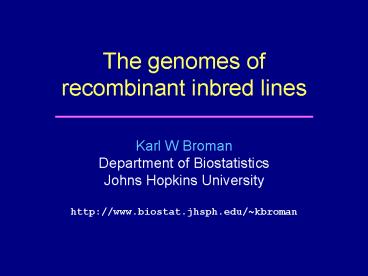The genomes of recombinant inbred lines - PowerPoint PPT Presentation
Title:
The genomes of recombinant inbred lines
Description:
Study the clustering of the breakpoints, as a function of crossover interference in meiosis. ... Strong positive crossover interference. Inbreed to complete fixation ... – PowerPoint PPT presentation
Number of Views:95
Avg rating:3.0/5.0
Title: The genomes of recombinant inbred lines
1
The genomes ofrecombinant inbred lines
- Karl W Broman
- Department of Biostatistics
- Johns Hopkins University
- http//www.biostat.jhsph.edu/kbroman
2
Recombinant inbred lines
(by sibling mating)
3
Recombinant inbred lines
(by selfing)
4
The Collaborative Cross
5
Genome of an 8-way RI
6
The goal
- Characterize the breakpoint process along a
chromosome in 8-way RILs. - Understand the two-point haplotype probabilities.
- Study the clustering of the breakpoints, as a
function of crossover interference in meiosis.
7
Why?
- Its interesting.
- Later statistical analyses will require
- The two-point probabilities.
- A model for the whole process.
- Actually, well probably just assume that
- The breakpoints follow a Poisson process.
- The genotypes follow a Markov chain.
8
2 points in an RIL
- r recombination fraction probability of a
recombination in the interval in a random meiotic
product. - R analogous thing for the RIL probability of
different alleles at the two loci on a random RIL
chromosome.
9
Haldane Waddington 1931
Genetics 16357-374
10
Equations for selfing
11
Recombinant inbred lines
(by selfing)
12
Recombinant inbred lines
(by sibling mating)
13
Equations for sib-mating
14
Result for sib-mating
15
The Collaborative Cross
16
8-way RILs
- Autosomes
- Pr(G1 i) 1/8
- Pr(G2 j G1 i) r / (16r) for i ? j
- Pr(G2 ? G1) 7r / (16r)
- X chromosome
- Pr(G1A) Pr(G1B) Pr(G1E) Pr(G1F) 1/6
- Pr(G1C) 1/3
- Pr(G2B G1A) r / (14r)
- Pr(G2C G1A) 2r / (14r)
- Pr(G2A G1C) r / (14r)
- Pr(G2 ? G1) (14/3) r / (14r)
17
Computer simulations
18
The X chromosome
19
3-point coincidence
- rij recombination fraction for interval i,j
- assume r12 r23 r
- Coincidence c Pr(double recombinant) / r2
- Pr(recn in 23 recn in 12) / Pr(recn in
23) - No interference ? 1
- Positive interference ? lt 1
- Negative interference ? gt 1
- Generally c is a function of r.
20
3-points in 2-way RILs
- r13 2 r (1 c r)
- R f(r) R13 f(r13)
- Pr(double recombinant in RIL) R R R13 /
2 - Coincidence (in 2-way RIL) 2 R R13 / 2
R2
21
Coincidence
No interference
22
Coincidence
23
Why the clusteringof breakpoints?
- The really close breakpoints occur in different
generations. - Breakpoints in later generations can occur only
in regions that are not yet fixed. - The regions of heterozygosity are, of course,
surrounded by breakpoints.
24
Coincidence in 8-way RILs
- The trick that allowed us to get the coincidence
for 2-way RILs doesnt work for 8-way RILs. - Its sufficient to consider 4-way RILs.
- Calculations for 3 points in 4-way RILs is still
astoundingly complex. - 2 points in 2-way RILs by sib-mating
- 55 parental types ? 22 states by symmetry
- 3 points in 4-way RILs by sib-mating
- 2,164,240 parental types ? 137,488 states
- Even counting the states was difficult.
25
Coincidence
26
Whole genome simulations
- 2-way selfing, 2-way sib-mating, 8-way sib-mating
- Mouse-like genome, 1665 cM
- Strong positive crossover interference
- Inbreed to complete fixation
- 10,000 simulation replicates
27
No. generations to fixation
28
No. gens to 99 fixation
29
Percent genome not fixed
30
Number of segments
31
Segment lengths
32
Probability a segmentis inherited intact
33
Length of smallest segment
34
No. segments lt 1 cM
35
Summary
- RILs are useful.
- The Collaborative Cross could provide one-stop
shopping for gene mapping in the mouse. - Use of such 8-way RILs requires an understanding
of the breakpoint process. - Weve extended Haldane Waddingtons results to
the case of 8-way RILs. - Weve shown clustering of breakpoints in RILs by
sib-mating, even in the presence of strong
crossover interference. - Formulae for the 3-point problem in 8-way RILs
elude us, - but we can obtain numerical results.
- We used simulations to study other features of
RILs.
36
The key points
- R 7 r / (1 6 r)
- 2-point probabilities, for the autosomes of 8-way
RILs, have all off-diagonal elements identical. - 3-point coincidence on 8-way RIL is near 1.

